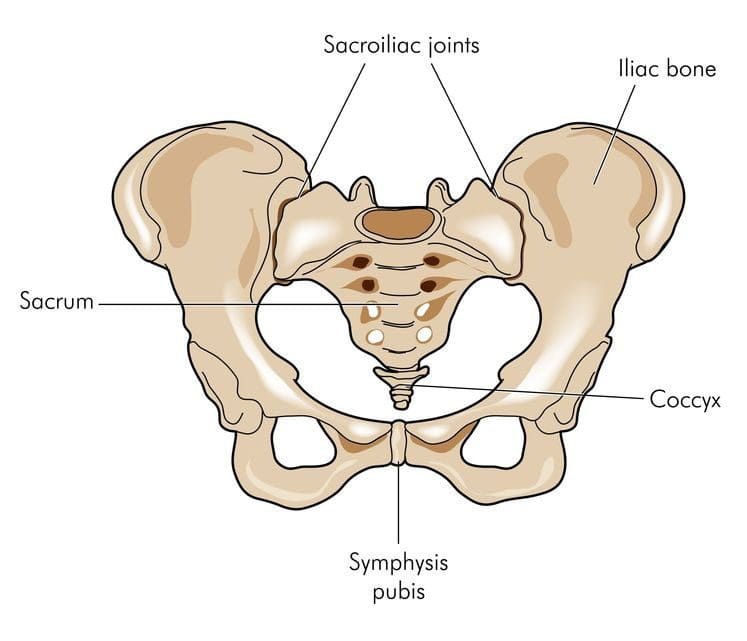Tailbone Pain or Coccydynia El Paso, Texas
Tailbone pain begins in the coccyx, which is located at the bottom of the spine’s sacrum.
Coccydynia (kŏk′sĭ-dĭn′ē-ə) is the term for pain in the coccyx, or tailbone.
Sitting and leaning back could be very uncomfortable.
However, pretty much everybody responds well to conservative treatment.
Table of Contents
Spinal Anatomy of the Coccyx
The coccyx, or tailbone, is the lowest area of the spine. It sits right below the sacrum.
The tailbone is made up of 3 to 5 small bones fused together by around age 30.
The coccyx helps support our weight while sitting.

Risk Factors
The prevalence of coccydynia is still unknown, but medical research has found that the condition affects:
- Adolescents
- Adults
- Women
- People that are overweight
However, women and those that are overweight are the two highest risk factors.
Women are affected five times more than men, which is likely due to injuries from childbirth.
Also, a woman’s coccyx is farther back than the male counterpart. This makes it more vulnerable to trauma.
Obesity causes coccydynia because of the extra weight/pressure on the coccyx, which alters how a person sits.
Causes
There are several causes, the most common are:
Trauma from:
- Falling
- Getting bumped/hit
Repetitive/Extensive:
- Bike riding
- Rowing
and Childbirth
Activities like these can bruise, break, and even dislocate the tailbone.
If this happens there could be painful inflammation and muscle spasms in the tailbone area.

Other possible causes:
Bone spurs: A small bone spur on the lowest part of the coccyx can pinch the surrounding area, and cause pain and discomfort while sitting.
Joint instability: Sacrococcygeal joint (which connects the coccyx and sacrum) allows too much or too little movement.
- Osteoarthritis
Rare causes are:
- Infection
- Metastatic cancer
- Chordomas
- Arachnoiditis
Coccydynia pain can mimic:
- Lower back pain
- Sciatica
- Infection
- Pilonidal cysts (skin infection)
- Fractured bone
A doctor will rule out these causes to make a proper diagnosis.
Diagnosing
A doctor utilizes medical history and physical exam to diagnose coccydynia.
Imaging scans are usually not necessary, but a doctor may order:
- Computed tomography (CT) scan
- Magnetic resonance imaging (MRI) scan
If they believe a separate:
- Bone
- Nerve
- Tissue
Problem to be the cause of tailbone pain.
Medical history is important, a doctor wants to know if a
- Fall
- Accident
- Recent trauma
Might have caused the pain.
A physical exam is next in line along with symptoms.
The pain is usually localized in the tailbone, making it straightforward to diagnose.
A doctor will want to know if the pain strikes when sitting or leaning back and which is worse.
A doctor might ask the patient to point to where they’re feeling the pain.
Pointing could be enough for the doctor to tell if the pain is coccydynia when compared to other low back pain conditions.
The doctor will want to palpate the tailbone area for signs of inflammation.
Non-surgical Treatment
Conservative treatment is extremely effective for coccydynia.
Ninety percent of people experience pain reduction using non-surgical means or any medical intervention.
It is first treated with noninvasive methods:
- Ice or heating pad can help provide immediate, short-term relief.
- Donut/Wedge cushion provides extra padding taking the pressure off the coccyx when sitting. These cushions are available at pharmacies.
- Avoid sitting for long times, like a long flight will help prevent additional pain and injury.
- Rest is very important to help avoid further injury during recovery.
If there is still pain after these therapies, a doctor may recommend over-the-counter or prescription-strength non-steroidal anti-inflammatory drugs (NSAIDs) or other pain medications.
If the medication doesn’t work then a doctor may try cortisone injection or local spine blocker to send strong medicine directly to the tailbone area.
Surgical Procedure
If none of the conservative treatments work then surgery could be the next step.
The procedure is called a coccygectomy, which means the removal of the tailbone.
A surgeon will discuss the procedure in great detail before it is performed.
These risks include:
- Infection
- Hematoma (abnormal collection of blood outside an artery or vein)
- Perineal hernia (weakened pelvic muscles)
Chronic Coccydynia
A small portion of people can develop chronic coccydynia, which means the pain lasts for more than 2 months.
Chronic coccydynia can take a major toll on the quality of life. Talk to a doctor if symptoms are not resolving.
They may refer you to a doctor that specializes in coccydynia management.
Protecting the Tailbone
There is no exact way or method to prevent coccydynia,
However, reducing the risk of tailbone pain can be achieved by using caution when participating in sports like:
- Skating – Ice, Inline, and Roller
- Biking
- Horseback riding
And take extra care when walking on icy/slippery/hazardous conditions so nobody falls.
El Paso, TX Chiropractic Severe Back Pain Treatment
Gale Grijalva suffered from acute back pain because of an automobile accident injury. Where it was very tough to do her regular daily activities, Gale Grijalva is now able to participate in physical activities she was not able to engage in before thanks to Dr. Alex Jimenez, a chiropractor in El Paso, TX. Gale Grijalva clarifies how individual Dr. Jimenez is and she discusses how thoroughly he has managed to help her, such as by answering any concerns she might have. Gale Grijalva also experienced results throughout rehabilitation.
Severe chronic back pain is a severe, recurring condition that affects an individual’s everyday life. Back pain lasting over three weeks is deemed chronic. The spine is an essential component of the human body. Severe chronic back pain may be the backbone’s way of telling the body that there’s a problem. The backbone is composed of bony vertebrae, soft spinal discs, facet joints, tendons, ligaments, and tendons. Within the bony thoracic artery lies the spinal cord, the more delicate but efficient nerve pathway of the central nervous system.
NCBI Resources
Before you run screaming in horror to the medicine cabinet, one of the best reasons to participate in chiropractic treatment is that it helps reduce the chance of a recurrence. By working on the total body and getting it in the best shape possible, the patient is stronger and more balanced to handle their workload and other strenuous activities. Chiropractors also impart advice on how to minimize the chances of re-aggravating the lower back.
Millions of people suffer from back pain each year, and some never visit a chiropractor. Those who do choose chiropractic treatment are privy to treatment that reduces their pain, increases healing, shortens their downtime and lessens their chances of a recurrence. If over the counter medication and ice packs haven’t worked within a few days, it’s time to make an appointment for a consultation with a licensed chiropractor. You will be happy you did.
Post Disclaimer
Professional Scope of Practice *
The information on this blog site is not intended to replace a one-on-one relationship with a qualified healthcare professional or licensed physician and is not medical advice. We encourage you to make healthcare decisions based on your research and partnership with a qualified healthcare professional.
Blog Information & Scope Discussions
Welcome to El Paso's Premier Wellness and Injury Care Clinic & Wellness Blog, where Dr. Alex Jimenez, DC, FNP-C, a board-certified Family Practice Nurse Practitioner (FNP-BC) and Chiropractor (DC), presents insights on how our team is dedicated to holistic healing and personalized care. Our practice aligns with evidence-based treatment protocols inspired by integrative medicine principles, similar to those found on this site and our family practice-based chiromed.com site, focusing on restoring health naturally for patients of all ages.
Our areas of chiropractic practice include Wellness & Nutrition, Chronic Pain, Personal Injury, Auto Accident Care, Work Injuries, Back Injury, Low Back Pain, Neck Pain, Migraine Headaches, Sports Injuries, Severe Sciatica, Scoliosis, Complex Herniated Discs, Fibromyalgia, Chronic Pain, Complex Injuries, Stress Management, Functional Medicine Treatments, and in-scope care protocols.
Our information scope is limited to chiropractic, musculoskeletal, physical medicine, wellness, contributing etiological viscerosomatic disturbances within clinical presentations, associated somato-visceral reflex clinical dynamics, subluxation complexes, sensitive health issues, and functional medicine articles, topics, and discussions.
We provide and present clinical collaboration with specialists from various disciplines. Each specialist is governed by their professional scope of practice and their jurisdiction of licensure. We use functional health & wellness protocols to treat and support care for the injuries or disorders of the musculoskeletal system.
Our videos, posts, topics, subjects, and insights cover clinical matters and issues that relate to and directly or indirectly support our clinical scope of practice.*
Our office has made a reasonable effort to provide supportive citations and has identified relevant research studies that support our posts. We provide copies of supporting research studies available to regulatory boards and the public upon request.
We understand that we cover matters that require an additional explanation of how they may assist in a particular care plan or treatment protocol; therefore, to discuss the subject matter above further, please feel free to ask Dr. Alex Jimenez, DC, APRN, FNP-BC, or contact us at 915-850-0900.
We are here to help you and your family.
Blessings
Dr. Alex Jimenez DC, MSACP, APRN, FNP-BC*, CCST, IFMCP, CFMP, ATN
email: coach@elpasofunctionalmedicine.com
Licensed as a Doctor of Chiropractic (DC) in Texas & New Mexico*
Texas DC License # TX5807
New Mexico DC License # NM-DC2182
Licensed as a Registered Nurse (RN*) in Texas & Multistate
Texas RN License # 1191402
ANCC FNP-BC: Board Certified Nurse Practitioner*
Compact Status: Multi-State License: Authorized to Practice in 40 States*
Graduate with Honors: ICHS: MSN-FNP (Family Nurse Practitioner Program)
Degree Granted. Master's in Family Practice MSN Diploma (Cum Laude)
Dr. Alex Jimenez, DC, APRN, FNP-BC*, CFMP, IFMCP, ATN, CCST
My Digital Business Card


